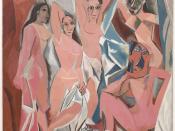Shock art is any type of artwork that employs shock to make a point, ask a question, or
purely to capture the audience's attention. These days everything has changed. The very meaning of the word 'Art' has become compromised. It is a common opinion within the public today that art is only valued for its ability to shock. And if it isn't shocking - it isn't art! In art, taboo images are no longer taboo. That means artists have to push further. Therefore art becomes even more shocking as time goes on. Throughout time, artists have been attempting to do one thing and that is to make us think differently.
Art has always shocked the society in which it is created. Even the likes of Manet, Van Gogh and Picasso were all criticized by the public in one way or another. One of the major paintings that caused such an outcry was Manet's "Dejuner sur l'herbe" (Luncheon on the grass) this dated back to the mid Nineteenth century.
The vulgarity of this piece caused it to be considered as "Shock Art." In the early twentieth century Picasso seemed to be echoing this specific type of art when he painted "Les Demoiselles D'avignon" consisting of five prostitutes in a brothel. Picasso appeared to be turning his back on middle-class society and the traditional values of the time. Here Innovation caused controversy.
Photographs and paintings such as Manet's and Picasso's shield the viewer in a way; they provide a barrier so the extent of the shock effect is reduced. Marcel Duchamp, in effect, invented the term "Shock Art" (in the context that we would understand it today) when he created his infamous piece "The fountain." Can a urinal be classified as a work of art? From this moment...


